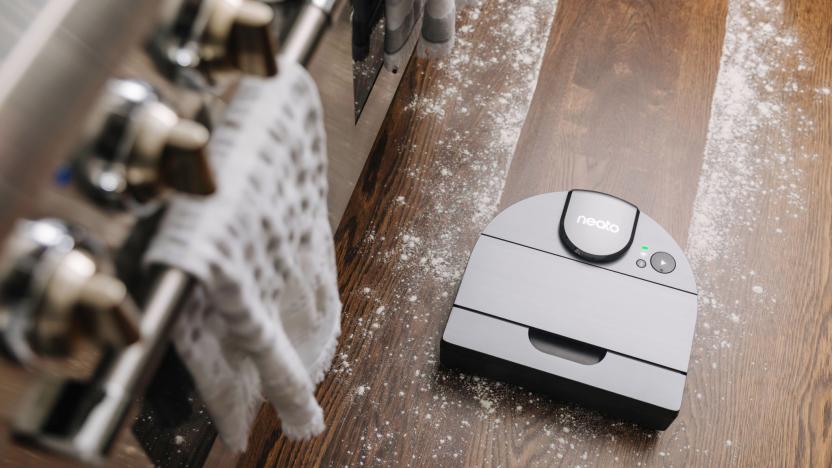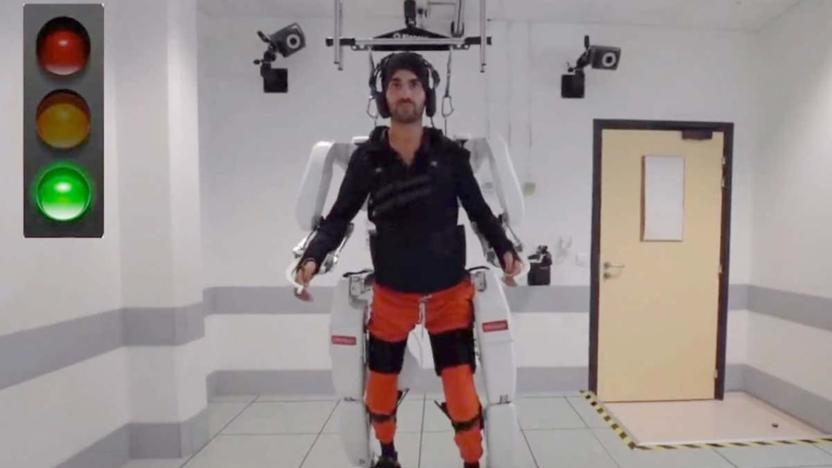robotic
Latest

Neato’s robotic D10 vacuum uses LIDAR-based navigation
Neato’s newest robotic vacuum, the Neato D10, uses LIDAR-based mapping technology and a HEPA filter.
Christine Fisher09.04.2020
South Korean cafe uses robotic baristas to comply with social distancing
A cafe in Daejeon, South Korea, is using robots to prepare drinks and deliver them to customers.
Christine Fisher05.26.2020
iRobot suspends plans to launch its robotic lawn mower
iRobot suspends plans for its robotic lawn mower, Terra, due to COVID-19.
Christine Fisher04.29.2020
A mind-controlled exoskeleton helped a paralyzed man walk again
A paralyzed man regained the ability to walk with the help of a robotic exoskeleton that he controlled with his mind. Unlike other, more invasive mind-controlled robotics, this one used electrodes implanted above the brain's outer membrane, not in the brain itself. That could reduce the risk of infection and other obstacles that have limited the success of mind-controlled robotics.
Christine Fisher10.04.2019
MIT’s thread-like robot can slip through blood vessels in your brain
MIT engineers created a thread-like robot that can glide through the brain's blood vessels and could deliver clot-reducing drugs to treat strokes or aneurysms. The robotic thread could offer an alternative to open brain surgery, and it could be controlled by surgeons outside of the operating room. Theoretically, surgeons could control it remotely from an entirely different location.
Christine Fisher08.29.2019
This hip-hugging exosuit uses AI to make walking and running easier
Robotic devices have been used to help people walk or run in rehabilitation settings, but until now, they've been tethered and limited to a single action, like walking or running. In a paper published in Science today, a team of researchers explain how they're going to change that. The researchers -- from Harvard University and the University of Nebraska Omaha -- have developed a portable exosuit that uses AI to assist users with both walking and running.
Christine Fisher08.15.2019
IKEA is working on robotic furniture for small apartments
IKEA wants to "empower people to have big dreams for small homes." To do so, it's creating a line of robotic furniture. Today, the company announced that it's partnering with Ori, an American startup that develops robotic furniture meant to address the challenges of small apartment living. IKEA and Ori will introduce their new line, dubbed ROGNAN, in 2020.
Christine Fisher06.04.2019
Robots are learning to carefully peel lettuce leaves
Technology is designed to improve and streamline every facet of life, and that inevitably includes areas most people would never even think about. Such a lettuce peeling. A random issue for many, perhaps, but for the agriculture industry, a new development in this field is a big deal. Researchers from Cambridge University have developed the first robotic lettuce leaf peeling system, which not only demonstrates advances in automation, but addresses increasing food and labor demands.
Rachel England09.26.2018
This is the desk lamp of your (robotic) dreams
It's back-to-school season. For some of you, this means needing a fancy new lamp for your home or dorm room desk. Unfortunately whatever Walmart, Amazon or IKEA may have in stock won't come anywhere close, both in terms of looks or functionality, to Anodos' RAL 9000 desk lamp. The Japan-based firm, which was behind one of the first connected set-top displays, decided to create a crazy, sleek lamp with an LED display, six cameras, a motorized arm and sensors that help it determine its positioning. There are no pricing or availability details right now, but we sure hope it goes on sale at some point. Because who wouldn't want one of these on their desk? Doesn't matter if you want it for school, work or simply for fun.
Edgar Alvarez08.17.2015
eatART's Mondo Spider cruises around CES 2013 (video)
It's sort of like Burning Man meets CES, meets a giant rideable robotic spider. eatART's eight-legged, 1,600 metal arachnid made the trip from Vancouver in order to cruise around the grounds of the Las Vegas Convention Center -- and thankfully we had a great view from our CES trailer. The big bug has been kicking around since 2006, but this is its first trip to the Consumer Electronic Show. We'd tell you more, but it's probably best to just watch the thing in action after the break. Kevin Wong contributed to this report. Follow all the latest CES 2013 news at our event hub.
Brian Heater01.07.2013
Samsung Smart Tango Corner Clean robotic vacuum hits Flickr ahead of CES launch
There's no doubt that Samsung's holding its juiciest bits for the stage in Vegas, but the company has been letting a few items slip on by, with an update to its robotic vacuum line representing the latest pre-CES tease. The Smart Tango Corner Clean maintains a traditional circular design, but includes the "world's very first pop-out brush," which enables the bot to whip debris out of corners and otherwise inaccessible spots along its mapped-out path. On the navigation front, the new cleaner appears to include Samsung's camera-equipped Visionary Mapping System, with a front-mounted lens. There's also a built-in LCD for programming and error code readouts, along with a handful of controls on the top and a standard removable dust bin in the rear. There's no hint of pricing or availability -- or even a model number to speak of -- but if you're in the market for an autonomous vac, you might as well hold out on your purchase for one more week.
Zach Honig01.01.2013
Robotic wheelchair concept adds leg-like movement, tackles stairs with ease (video)
Why choose between legs and wheels when you can have both? Well, that's the theory behind a robotic wheelchair concept from the Chiba Institute of Technology, which uses leg-like motion to conquer obstacles a run-of-the-mill wheelchair can't. The key is the five axes its base rotates on, allowing individual wheels to be lifted off the ground and moved in a walking style. It can tackle steps and various other obstacles whilst remaining stable, and can even turn 360 degrees around its center with the help of some onboard stabilizers. A gang of sensors on the chair detect incoming obstructions and deal with them automatically, but changes in wheel torque can act as substitute triggers, should the sensors fail. Judging from the video below, it's pretty advanced for a concept, but its creator wants a bunch of people to try it out so he can "fine-tune the user experience." It may not be quite as cool as Stompy or the mighty Kuratas, but it's definitely more practical for a trip to the shops.
Jamie Rigg10.15.2012
Insert Coin: Botiful telepresence robot for Android (video)
In Insert Coin, we look at an exciting new tech project that requires funding before it can hit production. If you'd like to pitch a project, please send us a tip with "Insert Coin" as the subject line. Remote-controlled cameras are nothing new -- heck, some even ride atop robotic vacuums -- but this Android smartphone-powered device delivers quite a bit of versatility in a petite package with a reasonable price tag to boot. Botiful, a "social telepresence robot," serves as a roving platform for your Android smartphone. You can move the handset (and its front-facing camera) up and down as it speeds along any flat surface, responding to commands from someone on the other end of a Skype video chat. Once you connect the device to your Android phone through Bluetooth or USB, you can control its direction from a pop-up window within Skype, letting you position Botiful however you see fit. If your Android phone doesn't have a front-facing camera, you can flip it around to use the rear shooter -- of course, you won't be able to see the display in this configuration, so it won't be ideal for two-way chats. Naturally, this makes the duo a natural choice for surveillance and baby monitoring, but it can also be used to provide a more immersive experience during conference calls or for sending back video from locations that aren't easily accessible, such as the undercarriage of a car. Designed in a garage in California (no, really), Botiful is already functional, with working software as well. The current configuration requires Skype for control, though an SDK will allow developers to create other control apps for the device -- and who knows, the seemingly capable inventor could release another tool of her own before it's set to hit production later this year. With much of the design already completed, the project sponsor is turning to Kickstarter to raise the funds necessary to launch Botiful to production -- the device could ship as soon as November if it reaches a $90,000 goal before August 22nd. Available in white, blue or red, the remote-controlled rig is currently only compatible with Android, though iOS support may come if funding exceeds a $100k threshold. There's still more than three weeks to go to make your pledge, with a limited number of pre-order slots available for $199 (retail pricing is expected to come in at $299). Hit up the source link below to show your support.
Zach Honig07.27.2012
Visualized: a look inside iRobot's gadget-filled 'cool stuff room' (video)
We've all seen a Roomba at one point or another, be it picking up debris around our feet in a friend's living room or chauffeuring a courageous kitty for an entertaining clip on YouTube. Likely far less familiar, however, is iRobot's gadget-filled Massachusetts headquarters, including the museum-like "cool stuff room" in the lobby. There you'll find a large variety of autonomous devices, ranging from an early Roomba prototype that subs in a removable cloth for the vacuum to the relatively creepy My Real Baby -- an $89 doll that cries for food and offers realistic reactions to tickling. There's also plenty of industrial and military gear on hand, including a long cylindrical bot used for repairing oil rigs as they continue to operate, a full-size self-driving vehicle and a wall-climbing robot that uses suction cup wheels to ascend vertically. Some of the exhibits are downright creepy, such as a crab-like prototype which an iRobot employee referenced as being "inspired by nature," though the company's familiar household gadgets help to balance out the eerie. Sadly, the collection doesn't appear to be open to the public, though IEEE was granted a tour, which it graciously filmed for your enjoyment -- you'll find that video walkthrough just past the break.
Zach Honig07.19.2012
Browser-controlled robot lets you skip stones remotely, mentally escape the concrete jungle
Can't unwind without the aid of open spaces? Skippy the robot might be able to help you out. The aptly named bot lets you remotely skip stones across an Idaho pond using a simple web interface. After waiting for your turn in a virtual queue, the machine lets you adjust its aim, tweak the amount of force behind the pitch and dispatch a rock. Best of all, your stone jumping exploits are automatically recorded, letting you show off your skipping prowess. Devised as a way to raise awareness for Idaho's Sun Valley resort area during the summer months, the mechanical projectile chucker seems to be arduino-powered, and operates only during daytime hours. Check out the source to start pelting pebbles, or venture past the break for two short videos of the contraption in action.
Alexis Santos07.13.2012
Chinese androids wear tracksuits, play sports, but not at the same time (video)
When we last caught up with the Beijing Institute's family of bots, their abilities extended to slow (but pretty) tai chi moves. Returning three years later, we see that they're coming along nicely: BHR-4 is still going through the old graceful routines, but now he's wearing a human face and fetching sportswear to look like one of his creators. The 140-pound android beats certain Japanese alternatives by having both a fully-actuated body and a face that can mimic emotions, like surprise and fear when someone tries to give it a decent hair cut. Meanwhile, brother BHR-5 doesn't bother with appearances, but instead has graduated to playing ping-pong in the hope of one day taking on rivals from Zhejiang University. He uses high-speed image processing and 32 degrees of freedom to pull off rallies of up to 200 shots, and he'll do his utmost to impress you in the video after the break. [Image and video credit: CCTV-4]
Sharif Sakr07.09.2012
iCRAFT robotic feeding arm (eyes-on)
We're back for another day of exploring the Northeastern University labs. We checked out a handful of projects yesterday, including the HyCycle, a runner-up in the school's Capstone award. Today we checked out the winner: iCRAFT -- that's short for eye-Controlled Robotic Arm Feeding Technology. The project was developed by a group of seven electrical and computer engineering students looking to create an inexpensive solution for helping the disabled and elderly feed themselves at home. As the Apple-esque name implies, the project utilizes eye-tracking to help the user feed him or herself. The hardware side of the project involves a robotic arm and controller (which run a combined $640), a hacked Creative webcam and IR light (around $114), three bowls, a water bottle and a custom built power supply. On the software side, the team used the open-source ITU gaze tracker software, combined with a custom GUI. The whole thing is designed to be simple to use right out of the box -- though, being in prototype stage, there were naturally a few hiccups in the process. It didn't work perfectly when we demoed it today, but it certainly wasn't much more buggy than what many companies try to pass off as finished products. %Gallery-158173%
Brian Heater06.13.2012
Toshiba's ApriPetit portable robotic interface solves household problems, melts your heart
Remember ApriPoco? It's okay, we'll forgive you if not, but we can't say the same about a similar question asked about that fellow above here in a few years. With a heart and soul as warm as that found in Wall-E, Toshiba's newly-unveiled ApriPetit is around half as large as the aforesaid predecessor, standing just 5.9-inches tall and sporting a pair of eyes capable of staring straight through your being. It's described as a "portable robotic interface," able to understand and act on voice commands using a combination of speech recognition and text-to-speech software. The eyes themselves are said to double as "stereo cameras, which can find and recognize faces and determine how close they are." As of now, there doesn't seem to be any hard-and-fast plans for use, but it's clear that home health and service is an area of interest. Of course, we'd buy one just to converse with -- Malkovich has Siri; we'll take this cutey.
Darren Murph06.04.2012
Fish are lazy, naive, easily led by robots (video)
What does a fish look for in a leader? No doubt a nice fishy smell is important, and maybe a sense of direction too, but the overriding factor happens to be something much simpler, and indeed simple enough for a robot to mimic. Our old friend Maurizio Porfiri and a colleague from New York's Polytechnic Institute have shown that a fish-bot will quickly attract live followers if it has a nice, fluid swimming motion. When the stroke is just right, real fish will pull up alongside and visibly relax their own motion to conserve energy, just like geese flying at the rear of a 'vee' formation. It's hoped that, in the future, robots might be used to guide endangered fish populations away from oil spills and other calamities, in much the same way as battery-powered leaders have guided humanity since the dawn of time (allegedly).
Sharif Sakr02.26.2012
Sphero shipments delayed due to high demand, won't be here-o until January
Our hearts were aflutter with anticipation when the Sphero went up for pre-order last month, but that excitement has since been supplanted by a big knot of disappointment, because the smartphone-controlled robotic ball won't be hitting the market until after the holiday season. In a letter published yesterday, Orbotix CEO Paul Berberian attributed his company's setback to a fundamental economic quandary. "Demand has been greater than expected and our production capabilities are slower than we planned," Berberian wrote. "What that means is only a handful of orders are going to be fulfilled before the holidays and the majority of orders will be fulfilled in January." Writing on behalf of the manufacturer, Berberian went on to accept full blame for the delay, with rather admirable honesty: "We simply underestimated the number of units we'd need to make and, more importantly, we miscalculated how long it would take to bring up the production line." To make up for it, Orbotix is offering free expedited shipping to all customers who pre-ordered the device in time for the holidays, along with a free Sphero t-shirt.
Amar Toor12.09.2011